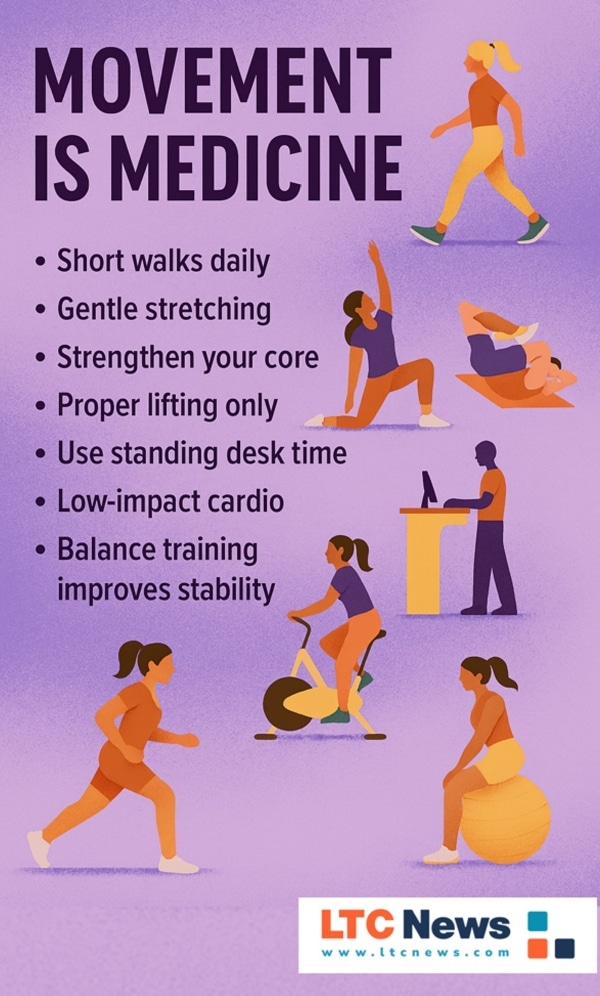Managing Back Pain as You Age and Protecting Your Independence

If you are like me and most people after a certain age, you start to feel it first when you get out of bed or after long periods sitting at a desk or in the car. That's right, back pain!
Back pain becomes more common every decade you live, and for many people, it becomes a daily companion. You do not want to lose strength, mobility, or your ability to do the things you love. You also want to avoid sliding from occasional pain into chronic limitation that could lead to long-term care later in life.
Back pain is not just an annoyance. It can be a major threat to quality of life and independence.
Why Back Pain Happens
You may develop back pain due to muscle strain, arthritis, or age-related disc changes. The Mayo Clinic notes that back pain is one of the leading causes of missed work in the United States.
Back pain is still a problem after you retire, as the National Health Interview Survey shows the percentage of adults with back pain rises with age, affecting 45.6 percent of people aged 65. At older ages, this pain can lead to a need for help with everyday living activities.
Common causes include:
- Muscle or ligament sprain or strain
- Degenerative disc disease
- Herniated or bulging discs
- Spinal stenosis
- Poor posture and weak core strength
These causes may overlap. Your back muscles protect and support your spine. If they weaken, the risk of injury increases.
Whether your issue is a herniated disc or spinal stenosis, disc herniation relief is possible, but this kind of pain can be quite severe at first. You might also simply have posture issues that are leading to back pain, which can be corrected over time.
Seeing a medical professional is the first step in feeling better.
How Back Conditions are Diagnosed and Why They Increase with Age
You often feel back pain as a dull ache, a sharp stab, or a burning sensation radiating down one or both legs. You may also feel stiffness when you wake up, tingling or numbness down the leg (sciatica), or pain that increases while sitting for long periods.
Clinicians diagnose back problems in several steps. Primary care physicians usually start with a detailed health history and physical exam. You may be asked to bend, twist, or lift your legs to look for specific nerve involvement. You might also get imaging tests. X-rays can show bone changes from arthritis or fractures. MRI scans can show herniated discs, spinal stenosis, and nerve compression. CT scans and nerve studies may help clarify more complex cases.
Back problems become more common as you age. The cartilage and discs that cushion your spine lose water and elasticity. The American Academy of Orthopedic Surgeons explains that degenerative disc disease is a normal part of aging, even though some people develop worse symptoms than others.
Why Back Pain Threatens Independence and Daily Living
When you cannot stand, bend, or lift safely, your life changes fast. You may stop gardening, golfing, walking longer distances, or traveling. Pain can also affect sleep. Fatigue then increases pain sensitivity and slows healing.
Back pain also reduces your ability to complete basic activities of daily living (ADLs). These activities include bathing, dressing, using the toilet, transferring from bed to chair, and eating. A once manageable pain flare in your 50s or 60s can become a chronic barrier in your 70s or 80s, especially if arthritis, osteoporosis, or spinal stenosis worsens.
Your risk of needing long-term care increases when mobility declines. People who cannot move safely may need help at home or may eventually move into assisted living or a nursing home.
For many families, this is a surprise. It is not just stroke or dementia that leads to long-term care. Chronic orthopedic pain conditions are a major driver.
The long-term care you or a loved one will need is costly, whether it is in-home care or in a long-term care facility. Those extended care costs vary depending on where you live.
- You can compare the cost of in-home care, assisted living, or nursing homes in your area using the LTC News Cost of Care Calculator.
Remember, health insurance, including Medicare, will not cover most long-term care services. If you or a loved one has Long-Term Care Insurance, the benefits will pay for your choice of extended care services, even at home. However, you usually obtain long-term care coverage before retirement.
Movement is Medicine
Staying active is one of the most important things you can do. The National Institute of Neurological Disorders and Stroke recommends that most adults with back pain avoid bed rest and keep moving if possible.
Gentle movement helps reduce stiffness and will protect your joint health. Many doctors recommend a combination of walking and core-strengthening exercises to help stabilize the spine.

Movement is therapy for most types of back pain. Light walking, stretching, and core work are some of the best tools you have to protect your back.
Heat, Cold, And Smart Self-Care
You can make use of heat and cold remedies, such as ice after sudden pain, to help reduce inflammation. Cold packs can reduce inflammation shortly after new pain flares. Heat can help loosen muscles once the initial inflammation settles. Most doctors recommend avoiding heavy lifting during flare-ups, but not becoming sedentary.
Consider reviewing your chair, work setup, and mattress. Posture support and ergonomics can make daily living less painful.
Know When to Get a Medical Evaluation
If pain is severe, does not improve, or radiates down your leg, you should get evaluated by a qualified clinician. A licensed physical therapist, primary care physician, or chiropractor can provide a treatment plan.
New numbness, weakness, or loss of bladder or bowel control is a medical emergency and requires urgent evaluation.
Back Pain and Future Care Planning
There is no question that chronic back pain and reduced mobility increase the need for help later in life. Aging brings many challenges, but proper planning will make them more manageable for you and your loved ones in the decades ahead.
Even more, proactive planning will improve your quality of life.
You have more control over back pain than you think. You have control over how proactive you are with your health and retirement plan. The sooner you take action, the better your chances of preserving strength, mobility, and independence.
If a loved one needs help with their daily living activities, be sure you get them quality care services. Use the LTC News Caregiver Directory to find options near them.


